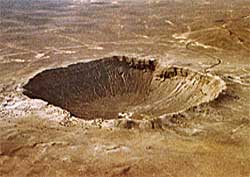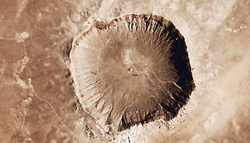Meteor Crater
 Why
Meteor Crater
is special
Why
Meteor Crater
is specialHundreds of other existing meteorite impact sites exist on earth, but the best preserved is the one in northern Arizona in America. The dimensions are astonishing: 1250 meters (4100 feet) wide and 172 meters (570 feet) deep.
Meteor Crater tips and insights
Meteor Impact
The impact of this solar system visitor was 150 times more powerful than the first atomic bomb explosion.
The earth has been struck many more times by meteors than the crater-covered moon, yet has few impact scars because of rain, wind and other forces that erase geologic features.
Yet, despite being 49,000 years old, Meteor Crater is in remarkable fine shape. Main reason: It lies in a very arid environment, which helps thwart erosion.
Astronaut training
Meteor Crater is so moonlike that astronauts trained inside for their lunar missions.
Operation
Meteor Crater is not part of the state or national park system. It is privately owned and operated.
The air-conditioned Learning Center on the north rim has two dozen educational exhibits and an 80-seat theatre showing a 10-minute introductory film.
Outside, there are observation platforms and several high-powered telescopes that permanently point to objects of interest.
The one-hour guided walking tour that skirts the northwest rim gives you a new perspective. In the summer, go on the morning's first tour to avoid the scorching midday heat of this high desert plateau.
 Meteor Crater
recent history
in brief
Meteor Crater
recent history
in briefDaniel Barringer
In the first half of the 20th century, mining engineer Daniel Barringer dug and drilled deep shafts into the crater floor to find the large remnant of the meteor so he could sell the metal. He failed in his mission, but some people call the geological formation "Barringer Crater" – and the shafts and some of his work buildings and construction gear remain in place today.
Eugene Shoemaker
Until about a half-century ago, the science community thought that Meteor Crater was volcanic, not meteoritic in origin. Then, astro-scientist Eugene Shoemaker successfully argued that it could only have been created by a powerful meteor impact because of two rare silica minerals found at the location.
Computer simulations
In 2005, scientists announced that computer simulations showed that the meteor fragmented and broke into pieces 14 meters (9 miles) before it hit the ground. And, the largest piece (which amounted to about half the original mass) was not traveling fast enough to melt appreciably its iron-nickel composition. That solved the century-old mystery of why large chunks of the fused metal normally associated with meteorites were never found.
Location in America



